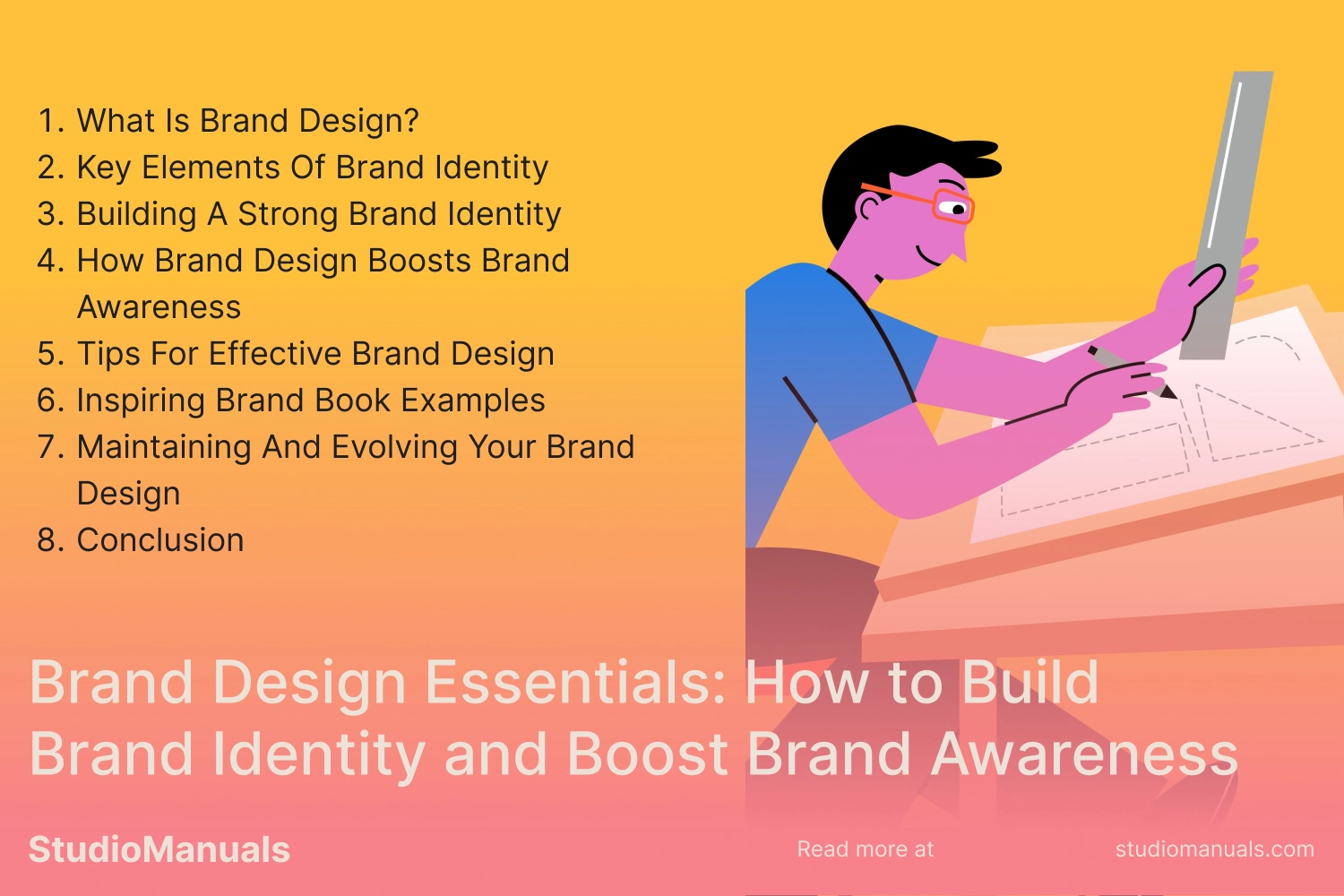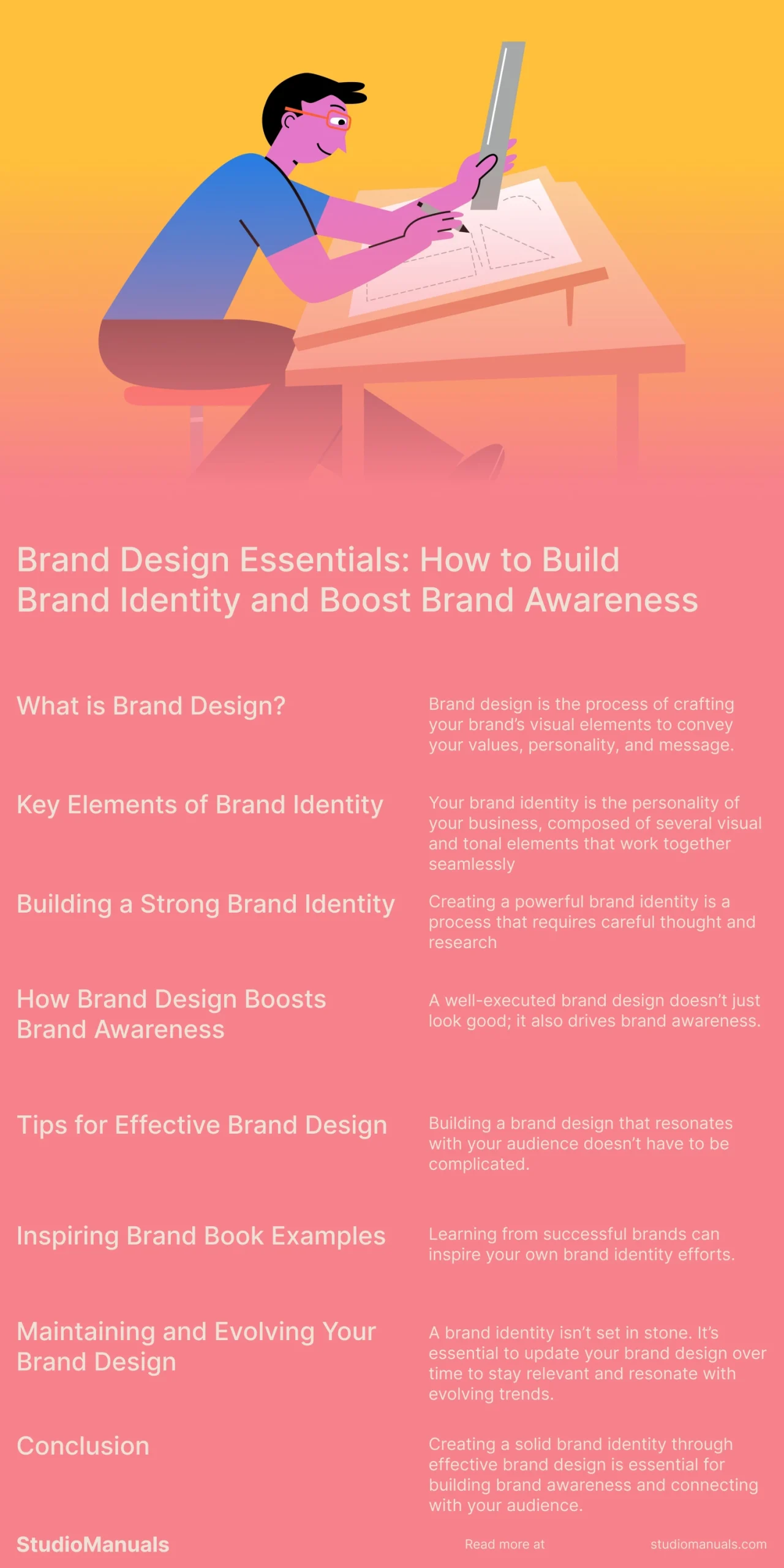Creating a strong, recognizable brand isn’t just about having a logo or a catchy tagline. It’s about establishing a cohesive brand identity and using design to enhance brand awareness. In this guide, we’ll break down the essentials of brand design, explain how to build a powerful brand identity, and show you how these efforts can significantly boost brand awareness.
In this article we will learn:
- What is Brand Design?
- Key Elements of Brand Identity
- Building a Strong Brand Identity
- How Brand Design Boosts Brand Awareness
- Tips for Effective Brand Design
- Inspiring Brand Book Examples
- Maintaining and Evolving Your Brand Design
- Conclusion
What is Brand Design?
Brand design is the process of crafting your brand’s visual elements to convey your values, personality, and message. It’s about creating a unique look that makes your brand instantly recognizable and connects with your audience. When done effectively, brand design helps establish trust, enhances credibility, and sets the foundation for a memorable brand experience.
Many ancient civilisations made use of branding in order to sell their goods to the masses. In ancient Babylon, merchants attracted buyers to purchase items such as spices, wines and rugs with a verbal sales pitch. LCCA

Key Elements of Brand Identity
Your brand identity is the personality of your business, composed of several visual and tonal elements that work together seamlessly. Let’s explore the essential components:
Logo
Your logo is often the first impression people have of your brand. A unique, well-designed logo creates instant recognition and sets the tone for your brand. Make sure it’s versatile and looks good across different platforms and sizes.
Color Palette
Colors evoke emotions and associations, so choosing the right color palette is essential. For instance, blue often represents trust, while red can convey excitement. Select colors that resonate with your brand’s values and use them consistently across your brand materials.
Typography
Fonts contribute to your brand’s tone of voice. Whether you choose a playful, bold font or a refined, minimalist one, ensure it aligns with your brand’s personality and stays consistent across all touchpoints.
Imagery and Visual Style
Your imagery should support your brand message and style. This includes photography, illustrations, and any icons or visual elements you use. Define a visual style that’s consistent and recognizable, whether it’s bright and dynamic or subdued and professional.
Voice and Tone
Your brand’s voice is the verbal expression of your identity. Is your brand friendly, formal, or humorous? Craft a voice that aligns with your values and resonates with your audience. Consistent voice and tone make your brand feel like a familiar friend to customers.
Building a Strong Brand Identity
Creating a powerful brand identity is a process that requires careful thought and research. Here’s how to approach it:
Understanding Your Audience
Get to know who you’re speaking to. Conduct research to understand your audience’s preferences, values, and needs. A brand that resonates with its audience is more likely to foster loyalty and drive engagement.
Establishing Brand Values and Mission
Define what your brand stands for. Your values and mission are the core of your brand identity and serve as a guide for every decision you make. These elements help differentiate your brand from competitors and build a loyal customer base.
Creating a Cohesive Visual Style
Once you’ve chosen your logo, colors, and fonts, it’s time to bring them together in a unified look. Consistency across all design elements strengthens your brand identity and makes your brand easier to recognize.
Consistency Across Platforms
To build a strong identity, consistency is key. Ensure your branding is cohesive across all platforms—website, social media, print materials, and more. Consistent design and messaging reinforce brand identity and build trust with your audience.
How Brand Design Boosts Brand Awareness
A well-executed brand design doesn’t just look good; it also drives brand awareness. Here’s how:
Building Recognition
When people see your logo, colors, or design style repeatedly, they start to recognize and remember your brand. Recognition is the first step in building awareness, as it makes your brand more memorable.
Increasing Trust and Credibility
A strong brand identity signals professionalism and reliability, making customers more likely to trust you. Consistency in brand design reassures people that your brand is dependable, which encourages them to engage with you further.
Standing Out in the Market
In a crowded marketplace, a distinctive brand design sets you apart from competitors. A unique identity and voice help you capture attention, making your brand more memorable and boosting awareness.
Tips for Effective Brand Design
Building a brand design that resonates with your audience doesn’t have to be complicated. Here are some tips for an effective design process:
Keep It Simple
Simplicity aids recognition. Avoid overly complex designs and focus on clarity. A simple logo or clean typography can be far more memorable than an intricate design.
Focus on Uniqueness
Make your brand stand out. Look at competitors to ensure you’re not blending in, and strive to create visuals and messaging that are distinctly yours.
Prioritize Flexibility
Your design elements should adapt easily across different platforms and formats. Make sure your logo, color palette, and other elements can be scaled and adapted without losing their impact.
Seek Feedback
Gather input from your audience and team members. Testing your brand with real users can provide valuable insights, allowing you to refine it to better suit your audience.
Inspiring Brand Book Examples
Learning from successful brands can inspire your own brand identity efforts. Here are a few examples:
- Nike: Known for its clean, bold design and powerful mission-driven messaging, Nike’s brand book exemplifies clarity and strength.
- Airbnb: Airbnb’s brand design emphasizes warmth and inclusivity, aligning perfectly with their values of community and belonging.
- Coca-Cola: A classic brand that has stayed true to its identity while evolving with the times, Coca-Cola’s branding showcases consistency and adaptability.
Maintaining and Evolving Your Brand Design
A brand identity isn’t set in stone. It’s essential to update your brand over time to stay relevant and resonate with evolving trends. Here’s how to keep your brand fresh:
Staying Relevant
The design landscape changes, and so do audience preferences. Review your brand design periodically to ensure it remains relevant and up-to-date with current trends.
Guidelines for Consistency
Creating brand guidelines helps maintain consistency as your brand grows. Clear guidelines on logo usage, colors, typography, and voice ensure everyone on your team is aligned with your brand identity.
Adjusting to Feedback and Trends
Be open to feedback from your customers and team. Adjusting your brand based on input and market shifts can improve its effectiveness and keep it aligned with audience expectations.
Creating a solid brand identity through effective brand design is essential for building brand awareness and connecting with your audience. By developing a consistent, cohesive brand, you not only set yourself apart from competitors but also lay the groundwork for lasting customer relationships. Invest time and effort in your brand design, and watch it become a powerful tool in your brand’s growth journey.





